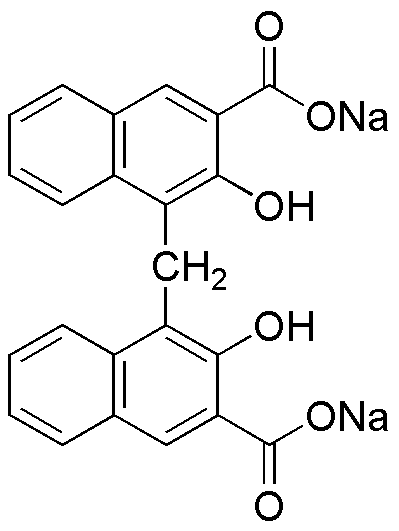Pamoic acid disodium salt is widely utilized in research focused on:
- Pharmaceutical Formulations: This compound is often used as a stabilizing agent in drug formulations, enhancing the solubility and bioavailability of active pharmaceutical ingredients.
- Analytical Chemistry: It serves as a reagent in various analytical techniques, helping researchers to identify and quantify other compounds in complex mixtures.
- Biochemical Research: Pamoic acid disodium salt is utilized in studies related to enzyme activity and metabolic pathways, aiding in the understanding of biochemical processes.
- Cosmetic Industry: Its properties make it suitable for use in cosmetic formulations, where it acts as an emulsifier and stabilizer, improving product texture and shelf life.
- Agricultural Applications: The compound is explored for its potential in developing eco-friendly pesticides and herbicides, contributing to sustainable agricultural practices.
General Information
Properties
Safety and Regulations
Applications
Pamoic acid disodium salt is widely utilized in research focused on:
- Pharmaceutical Formulations: This compound is often used as a stabilizing agent in drug formulations, enhancing the solubility and bioavailability of active pharmaceutical ingredients.
- Analytical Chemistry: It serves as a reagent in various analytical techniques, helping researchers to identify and quantify other compounds in complex mixtures.
- Biochemical Research: Pamoic acid disodium salt is utilized in studies related to enzyme activity and metabolic pathways, aiding in the understanding of biochemical processes.
- Cosmetic Industry: Its properties make it suitable for use in cosmetic formulations, where it acts as an emulsifier and stabilizer, improving product texture and shelf life.
- Agricultural Applications: The compound is explored for its potential in developing eco-friendly pesticides and herbicides, contributing to sustainable agricultural practices.
Documents
Safety Data Sheets (SDS)
The SDS provides comprehensive safety information on handling, storage, and disposal of the product.
Product Specification (PS)
The PS provides a comprehensive breakdown of the product’s properties, including chemical composition, physical state, purity, and storage requirements. It also details acceptable quality ranges and the product's intended applications.
Certificates of Analysis (COA)
Search for Certificates of Analysis (COA) by entering the products Lot Number. Lot and Batch Numbers can be found on a product’s label following the words ‘Lot’ or ‘Batch’.
*Catalog Number
*Lot Number
Certificates Of Origin (COO)
This COO confirms the country where the product was manufactured, and also details the materials and components used in it and whether it is derived from natural, synthetic, or other specific sources. This certificate may be required for customs, trade, and regulatory compliance.
*Catalog Number
*Lot Number
Safety Data Sheets (SDS)
The SDS provides comprehensive safety information on handling, storage, and disposal of the product.
DownloadProduct Specification (PS)
The PS provides a comprehensive breakdown of the product’s properties, including chemical composition, physical state, purity, and storage requirements. It also details acceptable quality ranges and the product's intended applications.
DownloadCertificates of Analysis (COA)
Search for Certificates of Analysis (COA) by entering the products Lot Number. Lot and Batch Numbers can be found on a product’s label following the words ‘Lot’ or ‘Batch’.
*Catalog Number
*Lot Number
Certificates Of Origin (COO)
This COO confirms the country where the product was manufactured, and also details the materials and components used in it and whether it is derived from natural, synthetic, or other specific sources. This certificate may be required for customs, trade, and regulatory compliance.


